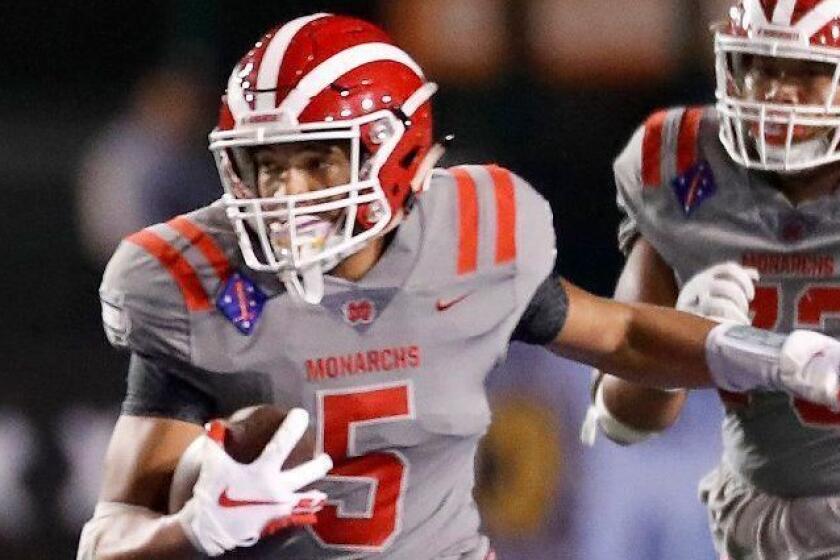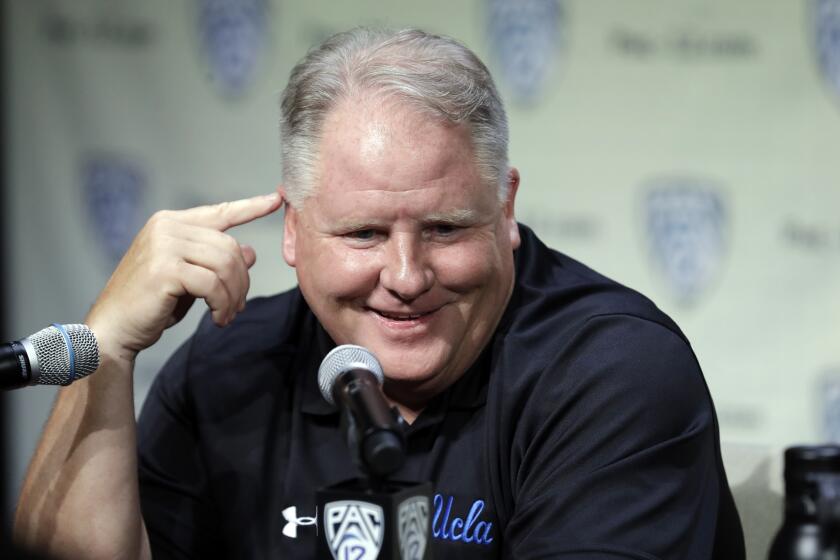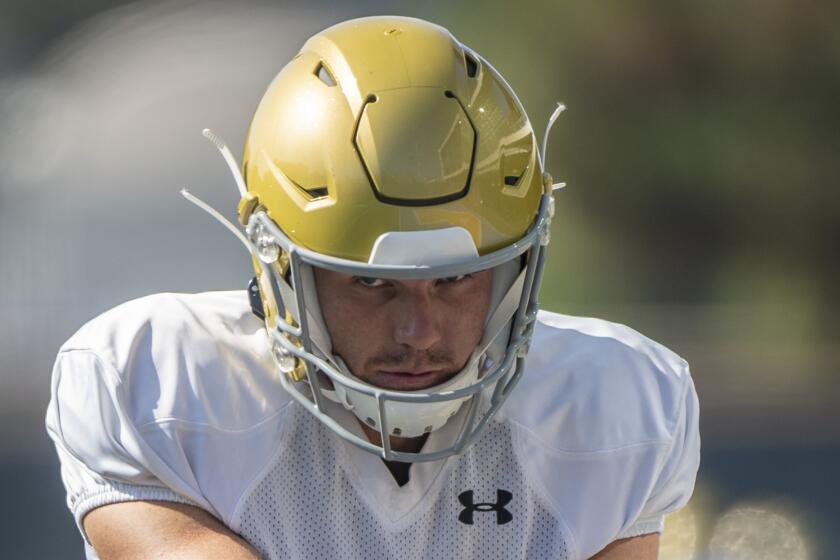Entering transfer portal is a tricky game to play for some at USC and UCLA
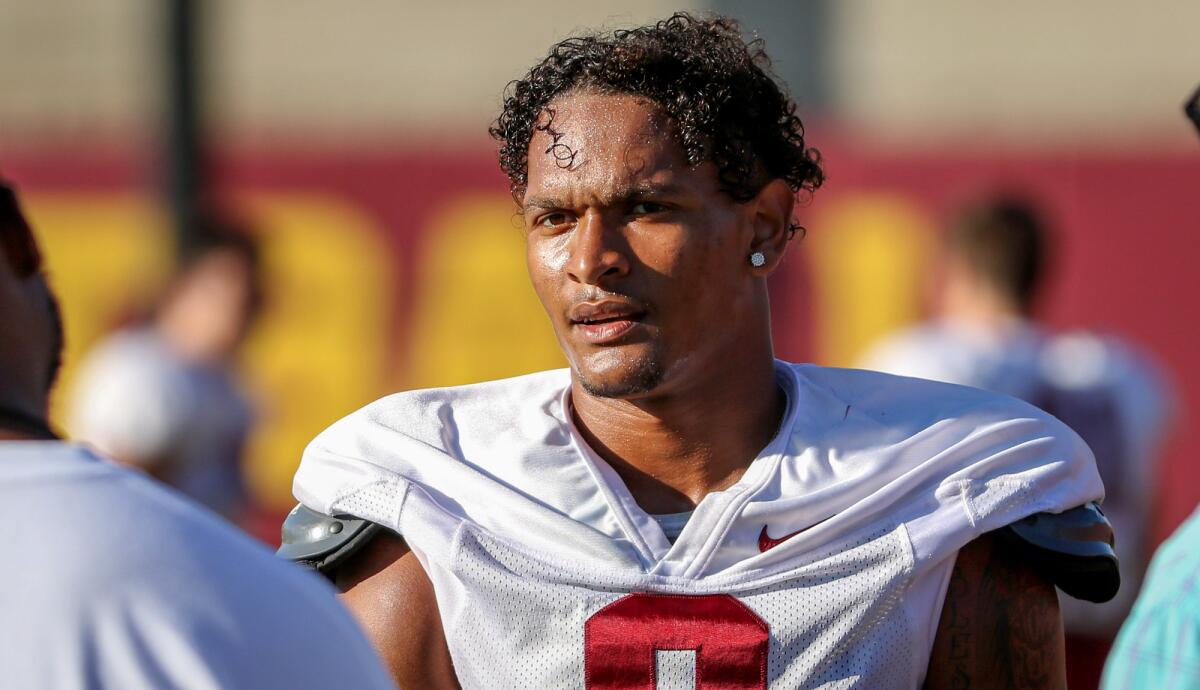
- Share via
Tell the truth. As Norman Steele saw it, it was all his son, Chris, could do. Explain to the NCAA exactly what went down at Florida to necessitate his transfer to USC. Then, cross your fingers and hope for the best.
“You just don’t know what might happen,” Norman said. “You don’t know because it’s up to their judgment call. We felt we had a pretty strong case, but you just never know.”
For athletes weathering the NCAA’s convoluted transfer and waiver processes, that crippling uncertainty is hardly uncommon.
At USC, where freshman Bru McCoy remains in waiver limbo, and at UCLA, where transfer quarterback Colson Yankoff’s immediate eligibility has been blocked by his previous school, that process has been put under the microscope this offseason.
The transfer portal, which went into effect last October, was intended to empower college athletes in revenue sports, replacing rules which required prospective transfers to receive permission before contacting other schools.
But amid myriad changes necessitated by the portal and updated guidelines governing immediate eligibility waivers, the process remains frustratingly opaque and inconsistent for the college athletes at the center of it, while NCAA coaches move freely from job to job, wielding power over transfer decisions whenever it suits them.
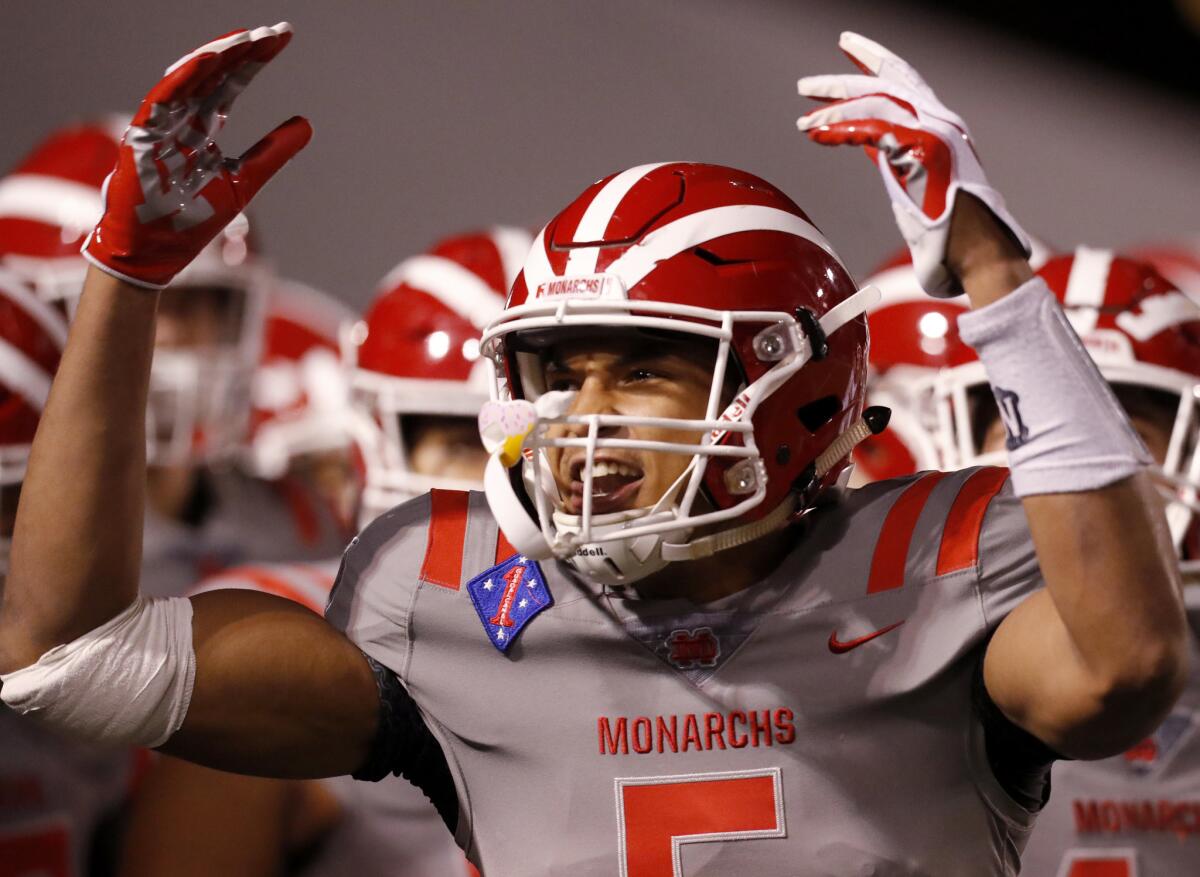
For Chris Steele, the highly touted cornerback prospect from Bellflower St. John Bosco High, his reasons for leaving Florida after one semester had nothing to do with football.
Steele and his family were upset with the school’s handling of an issue with his roommate, quarterback Jalon Jones, who had been accused of sexual battery. Outside of that, his father says, the family had no problem with Florida.
“But that was a glaring situation,” Norman Steele said. So Steele entered the transfer portal, beginning a long and winding process that would bring him back to USC, where he’d previously committed.
Steele did not need Florida’s permission to do so, as he would have prior to last October. In order to receive immediate eligibility in L.A., though, he and USC compliance would need to make a compelling case to the NCAA.
In petitioning for a waiver, Steele’s only control over the process would be a personal statement included in the application. To be approved, his case would need to prove “documented mitigating circumstances outside of the student-athlete’s control,” which, “directly impact the health, safety or well-being of the student-athlete.”
According to the NCAA committee for legislative relief, which rules on such waiver cases, the standard of proof for such “mitigating circumstances” is covered by 11 guidelines, ranging from egregious behavior by the original school to financial hardship to the health of a family member.
Two weeks into USC’s fall camp and two weeks out from its regular season debut, Bru McCoy has yet to see the practice field.
In June, as waivers requests increased significantly, those guidelines were adjusted to require even more specific proof and documentation, in order for waivers to be approved.
“These athletes have to sit out a year unless they beg for an exception, and in doing so, they have to provide personal, confidential information that no one wants to provide,” said Tim Nevius, an attorney and former NCAA investigator whose firm focuses on college athletics. “That’s just extremely inappropriate in my opinion.”
The NCAA acknowledges that those guidelines, “obviously can’t account for every possible circumstance,” says Brandy Hataway, NCAA director of academic and membership affairs.
Still, how a given case fits into that framework is often wildly subjective and arbitrarily enforced.
Nevius suggests that all collegiate athletes should be granted a one-time transfer exception — a rule that’s already in place for those not playing football, men’s basketball, hockey, or baseball. The NCAA considered such a change last year, but ultimately, opted to stick to the status quo.
“It’s simply unequal treatment,” Nevius said. “There’s no reason to not have a uniform rule that applies to all athletes in all sports.”
Instead, the waiver process is often left up to interpretation. And in many cases, that leaves the original school with an undue amount of influence over whether immediate eligibility is granted or not. Often, they are given the chance to rebut any sort of accusations made.
J. Brady McCollough looks at the biggest storylines in college football ahead of the 2019 season.
“There has to still be some sort of cordial relationship that exists even to get that documentation,” Nevius said. “If it’s a he-said, he-said situation, you’re unlikely to actually win that.”
In Chris Steele’s case, that wouldn’t be a problem. Florida offered its full blessing of Steele’s waiver and, according to his father, “were great throughout the process.” On Aug. 6, a week after USC opened fall camp, the NCAA granted Steele a waiver for immediate eligibility, and the family was fortunately able to put the saga behind them.
For UCLA’s Yankoff, it wouldn’t be so simple. A four-star quarterback from Idaho, Yankoff signed with Washington in December 2018. Soon after, Washington unexpectedly added a former five-star transfer from Georgia at the position, Jacob Eason, while the coordinator who most closely recruited him, Jonathan Smith, left to be Oregon State’s head coach.
There was no hardship necessitating his choice to transfer the following April. But for a variety of reasons, Yankoff entered his name into the transfer portal. Only a few weeks later, before he’d even chosen a new school, Washington’s staff alerted him in an email that it would not support his waiver for immediate eligibility, no matter where he decided to transfer.
At a later appeal, Washington told university administrators that their refusal was “for competitive reasons”. Yankoff ultimately landed at UCLA, which won’t play Washington for another two seasons.
When asked about such a scenario, the NCAA denied that an athlete’s original school could unilaterally deny a transfer waiver. But without Washington’s support, Yankoff’s waiver process has clearly ground to a halt. Recently, UCLA coach Chip Kelly suggested that “our hands are tied,” as it pertains to his immediate eligibility.
“I think everybody should be available,” Kelly said. “We don’t block anybody, that’s just our school and our [team] policy. So that’s a question for Washington, not us.”
Wade Lees thought he might be a star in Australian rules football one day. Instead, the 31-year-old will be the punter for UCLA this season.
At Pac-12 media day, Washington coach Chris Petersen made his opinion on transfers known, prefacing his comments by declaring himself “old school.”
“I’ve seen too many guys, including myself, have to work through hard things where maybe you tap out, or it’s easier [to say], ‘I’m going to go somewhere elsewhere [because] I think it’s better,’ ” Petersen said. “It’s usually not.”
Yankoff will likely have to wait on his chance to find out on the field. His family has yet to file paperwork with the Pac-12 or the NCAA, given the hurdles it has had to face with Washington. To them, it still makes little sense why Washington has any say at all.
“We’re not calling foul,” his father, Trevor Yankoff, said. “The process just needs to be better. It needs to be more consistent. There are just too many arbitrary aspects to it.”
As USC awaits the NCAA’s decision on McCoy, the particulars of that process are especially significant. McCoy, who signed with USC, then transferred to Texas, before transferring back to USC following the spring, is still seeking immediately eligibility.
That decision, according to USC coach Clay Helton, is expected before the Trojans open the season on Aug. 31. Given the lack of precedent in McCoy’s case, how the NCAA will actually rule remains a mystery.
Still, it will make a decision eventually — even if its guidelines don’t adequately fit McCoy’s circumstances. Until then, the McCoy family has no choice but to hope for the best from the NCAA, while preparing for the worst.
It’s a feeling to which many stuck in transfer limbo can relate.
“Any time you take a kid that’s like Bru who has never not played, the thought of possibly not being able to play this year is an unbearable thought,” Horace McCoy, Bru’s father, said. “We have to prepare him for that mentally. But right now, it’s a waiting game.”
More to Read
Go beyond the scoreboard
Get the latest on L.A.'s teams in the daily Sports Report newsletter.
You may occasionally receive promotional content from the Los Angeles Times.

